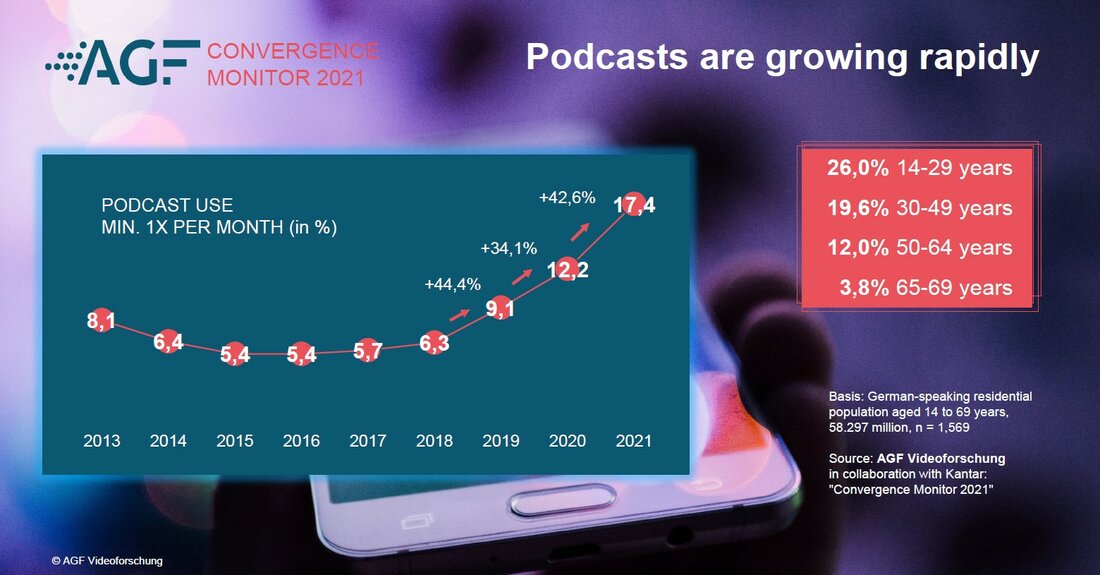Frankfurt, September 20, 2021. And the winner is …. Podcast! After Video-on-Demand services in particular made strong gains in the coronavirus-dominated year 2020, this year’s award for the strongest increase in usage goes to digital audio content. Compared to last year, podcast usage rose sharply again by 42.6 percent (2020: plus 34.1 percent; 2019: plus 44.4 percent). This is one of the findings of the CONVERGENCE MONITOR 2021, the study conducted by the market research institute Kantar on behalf of AGF Videoforschung. This study, which has been conducted for the last 14 years, delivers valuable time-series comparisons of German media usage trends and developments.
In the latest survey, 17.4 percent of respondents stated that they listen to a podcast at least once per month. Among 14-to-29 year-olds, this figure is already 26.0 percent. “Thanks to an ever-widening selection and interesting content, podcast usage is steadily increasing,” said Kerstin Niederauer-Kopf, CEO of AGF Videoforschung.
Playing music, audio plays and similar content is the most popular feature for those who use smart speakers like Amazon Echo/Alexa or Google Nest (70.6 percent). Listening to radio programs comes in second (54.3 percent), followed by weather reports and time of day announcements/timers (each 44.0 percent). Smart shopping, meaning ordering and purchasing goods from a digital voice assistant, only comes in 9th place at 7.5 percent. Overall, smart speaker usage increased by nearly 50 percent over the previous year, albeit from a relatively low level: 11.7 percent of respondents said that they personally use such a device. Thus, Alexa and other smart speakers are found in 11.4 percent of households – 31.0 percent more than in 2020.
Music streaming also continues to grow at a steady pace. 30.7 percent of respondents use this service at least once a month (2020: 28.5 percent). By contrast, YouTube has lost some of its appeal as a music playback platform, having declined by 4.6 percentage points from last year’s survey.
Further increase in the use of fitness trackers and Apple Watches
Germans looking to equip their households with media devices are increasingly purchasing not only smart speakers, but especially also smart watches and fitness trackers. These devices can now be found in 18.4 percent of households, corresponding to a substantial increase of 34.3 percent. In terms of persons, 15.3 percent say that they are using such a device – reflecting an impressive gain of 62.8 percent.
Internet usage is driven by communication and media
Internet usage remains at a high level of around 90 percent. Moreover, the TV set is becoming an increasingly important way of using the Internet. Since 2016, the percentage of persons who use a TV set as a means of accessing the Internet has nearly doubled to 30.0 percent (2020: 16.1 percent). As in the previous years, Germans mainly go online for the purpose of communication (88.4 percent) and media usage (83.2 percent). Transactions such as online banking and online shopping have become more prevalent (80.6 percent). “When you analyze the recent growth, you find that it is particularly attributable to an increase in online banking, whereas in the previous year, it was still driven by increased online shopping activity,” said Kerstin Niederauer-Kopf, CEO of AGF Videoforschung. Online videos represent the fourth most prevalent reason for Internet usage (76.0 percent), while content reading comes in last place (55.1 percent).
Social media and instant messaging play a crucial role in digital communication. In this regard, there have been no changes in the usage rankings from last year: WhatsApp at 80.5 percent is still well ahead of Facebook (46.9 percent), Instagram (27.2 percent) and Snapchat (11.0 percent). Use of the fast-growing video portal TikTok has increased substantially to 10.3 percent. Among B2B networks, Xing scores 5.8 percent, slightly ahead of the international competitor LinkedIn (5.2 percent).
The CONVERGENCE MONITOR survey has been conducted by Kantar every year since 2008, making it one of the few long-term studies of media usage in Germany. The study has been conducted under the auspices of AGF Videoforschung (AGF) since 2020. For this year’s study, Kantar interviewed 1,569 persons aged 14 to 69. Whereas only telephone interviews (CATIs) could be conducted in 2020 due to the coronavirus pandemic, face-to-face interviews were conducted this year again (field time: 30/03 to 16/05/2021). The universe comprises the German-speaking residential population, or households with at least one person between 14 and 69 years of age in Germany.
Methodology profile
Name of study: CONVERGENCE MONITOR
Conducted: Annually
Institute: Kantar
Survey method: Face-to-face interviews
Sample: Representative sample with n = 1,569
Field time: 30/03-16/05/2021
Universe: German-speaking residential population aged 14 to 69, or households with at least one person aged 14 to 69 in Germany
